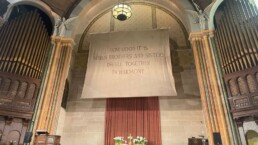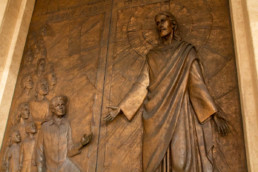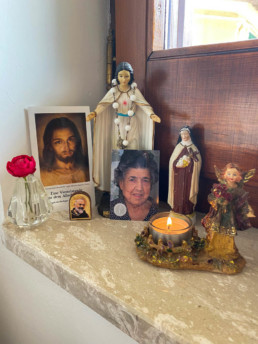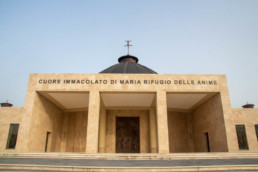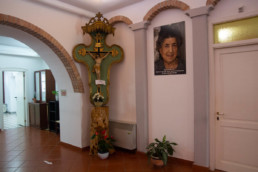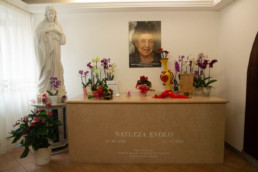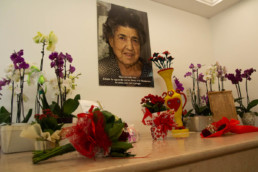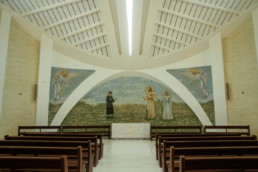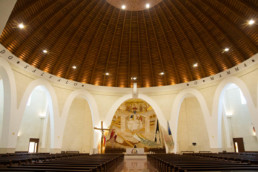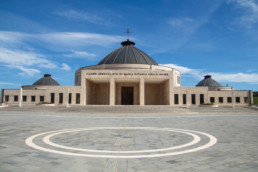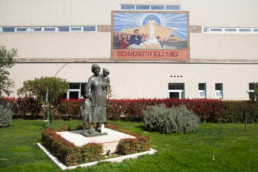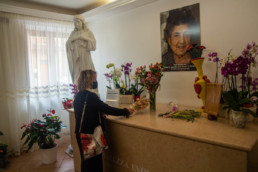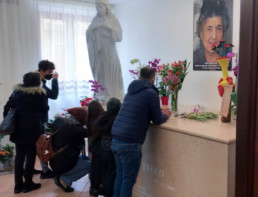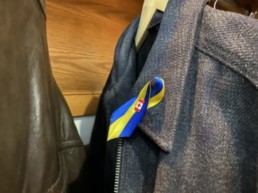Besties in Biblical Times
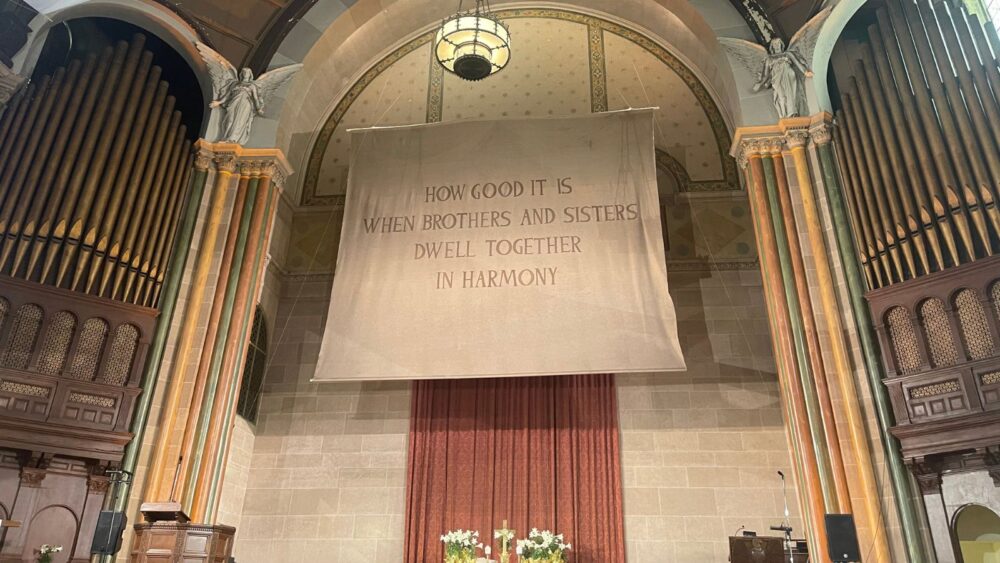
NEW YORK – Between two Christian spirituals, a rowdy group of seven kids run onto the stage during Sunday morning service at St. Paul & St. Andrew United Methodist Church on 86 Street on the Upper West Side.
A boy with a shaved head in a pink button-down takes the microphone and tells the congregation that he is going to his friend Jonah’s birthday party later that day. A coy girl in gingham with a long ponytail says her best friend Sophia always gives her presents. The congregation giggles.
However, the children’s chatty irreverence is not an interruption to the service. It’s time for the "Messages for All Ages" portion, during which the congregation’s youth and campus pastor, Ekama Eni, leads the children in a lesson before they head to the chapel for Sunday school. She teaches by example.
“I want to tell you about someone,” Eni says, leading off the message from the stage. She shows the children a photo of her friend Sam. “We cook together, we study together, we go to drag shows together. Would anyone like to tell me about their best friend?” What follows keeps the adults engaged, while the kids appreciate Eni saving them from the boredom of sitting quietly in a pew.
Eni tells the children that the Gospel reading they will hear while walking to Sunday school is about a man who is not feeling well and his four “besties.” The "besties" have heard that Jesus makes people better so they are going to take their friend to see him.
Theatrically retelling the story of Mark, chapter 2, when Jesus heals a paralyzed man, Eni says that the house where Jesus was at the time was very crowded, so the friends climbed onto the roof, cut a hole in the ceiling, and lowered their best friend into the house to see Jesus.
“That is dedication to being a bestie,” says Eni.
She emphasizes the importance of friends, those they can giggle with and do incredible things with, because Jesus loves them.
Eni, 30, graduated from Union Theological Seminary in 2021. She says that her approach to teaching kids is to invite mutual curiosity.
“I'm obsessed with the minds and thoughts of children,” she says after the service. “I'm always going to try and engage them most importantly as fellow human beings with thoughts and feelings.”
For Eni, it’s about making children feel like a part of the larger church community.
“Dear God, thank you for besties,” Eni says as she notices the children starting to get antsy. “Amen.” And the children scramble off to the chapel.
The Bride Price: A Teaching On Atonement At the Pentecostal Anointing Church of God
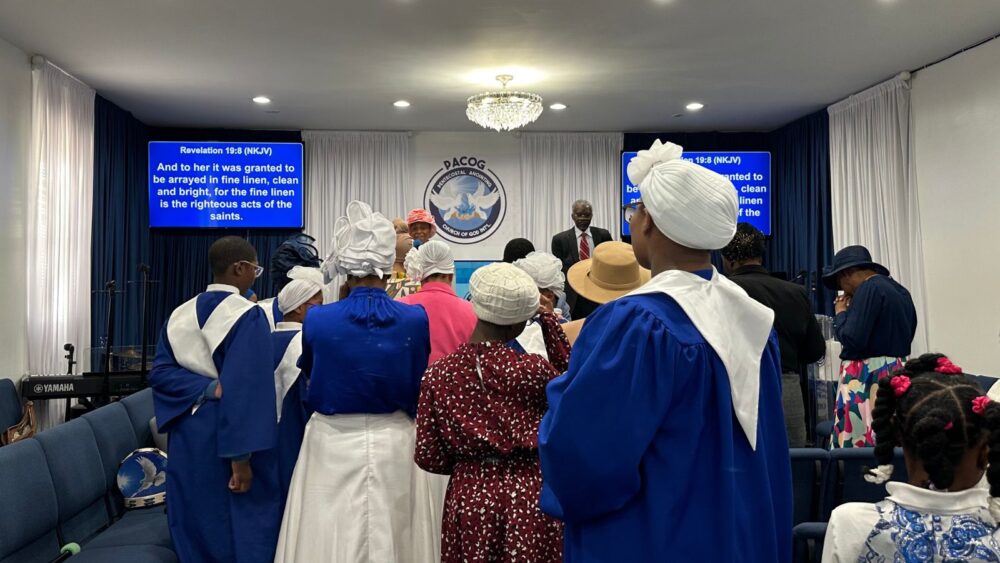
NEW YORK — The small sanctuary of the Pentecostal Anointing Church of God, located at 3112 Tilden Ave. in Brooklyn, was thunderous on Sunday with the sounds of no more than 30 worshipers clapping and shouting “hallelujah” as the congregational leader spoke.
All across the space, decorated in blue and white colors, Bibles were open. Children, who accounted for most of the small church community, pulled out composition notebooks to record the lesson God would teach them through the congregational leader, known to them as Mommy.
Moments before, at the beginning of Mommy’s teaching, the worshipers stood and read chapter 19 in the Book of Revelation aloud together.
“Revelation 19 is encouraging to us,” said Mommy. “The Lord is encouraging someone today.”
“Amen,” shouted the congregation in agreement.
In Nigerian Pentecostal tradition, church teachings are highly interactive, and a back and forth exchange between the preacher and the congregation is welcomed. At Pentecostal Anointing Church of God, it’s common for worshipers to burst into song multiple times throughout the teaching period.
Mommy re-read verse seven in Revelation 19 out loud to the crowd, “Let us rejoice and be glad and give him glory! For the wedding of the Lamb has come, and his bride has made herself ready.”
For Christians, the word “Lamb” is used throughout the Bible as a metaphor for Jesus Christ, and the word “bride” often represents the Church, or anyone who has put their faith in Jesus.
“American culture makes it very easy to get married,” Mommy said with a chuckle. “In Africa, where we are from, there is a thing called ‘bride price.’”
Mommy described a prominent tradition in West African tribal societies where the groom or groom’s family pays a sum of money to the bride or the bride’s family before the official wedding ceremony. She then spoke about the other things involved in addition to money, including yams, cakes, smoked fish and intricately designed outfits.
As Mommy spoke, her inflection emphasized her passion, ranging from a conversational tone to a holler. Members of the congregation laughed joyfully as they contemplated the difference in cultural traditions.
Then, Mommy’s facial expression grew serious as she drew a parallel between the bride price tradition to the atonement of Jesus Christ.
Christian doctrine teaches that it was Jesus who suffered the ultimate penalty in order to wipe clean the consequences of Sin for all mankind, allowing them to be reconciled to God.
“Did you see what Jesus did for us?” Mommy asked the congregation. “You don’t need to pay for marriage; you don’t need to pay for cake for marriage with God.”
Through giving his blood, Jesus himself paid for each individual to be his bride, said Mommy.
“If you have not put value to what Jesus did, please, I am encouraging you today,” said Mommy.
For the third time and final time, the congregation broke out into song. “Jesus paid it all. All to him I owe,” they sang exuberantly as Mommy’s teaching drew to a close.
A Great Mystic of our Time: Natuzza Evolo and the Catholic Church
Paravati, ITALY – When Fortunata Evolo, a 20th Century Italian mystic, was alive, thousands would come to this little village in Calabria to seek her guidance, inspiration and healing. She claimed to have apparitions of Jesus and Mary and said that she was able to communicate with the dead.
After her death in 2009, the pilgrims kept coming, declaring that she continued to perform miracles from her heavenly abode. They prayed at her tomb and finished building the “Villa of Joy,” a complex of buildings that Evolo said appeared to her in a vision. In 1944, she said, the Virgin Mary told her to build a church, a youth center and a senior center to help the people in need.
Evolo, known as “Mom Natuzza” by the faithful, is more than a local hero. Devotees all around the world, especially in Italian immigrant communities, have photos of her on their bedside tables and recite the rosary following her teachings.
Natuzza was treated as if she were a saint of the Catholic Church. In reality, she is not, but the Vatican is conducting a process whereby she may become one in the future.
Her cause for sainthood officially began three years ago, on April 6, 2019, when the Vatican initiated the process, which will conclude when the Congregation for the Cause of Saints decides on her sanctity or not. These proceedings are usually very long; the one for Saint Pius’ took 19 years.
The Vatican appointed an ecclesiastical tribunal to ascertain Natuzza’s alleged spiritual gifts during this very delicate process. “An ecclesiastical tribunal was set up to gather testimony and acquire documentation to make her a saint,” said Pasquale Anastasi, the Immaculate Heart of Mary Refuge of Souls Foundation president.
However, it seems that the faithful do not need an official declaration from the Vatican to recognize the spiritual powers and gifts of Natuzza. They continue to flock every year to Paravati, in the region known as Calabria, to pray for her intercession.
I grew up making regular visits to Calabria. I know the region and the unique religious dedication of the people who live here very well. This spring, I set out to explore the Natuzza causes. I traveled to Paravati and Mileto, visiting the places where Natuzza lived and professed her faith, spending her life in the service of others. Among these places is the “Villa of Joy,” which is formed by the church dedicated to the Immaculate Heart of Mary Refuge of Souls, a rest home, and a center for young people built according to Natuzza’s wishes. She said that the Virgin Mary herself told her just what the architecture of the church should look like, together with the other buildings of the Villa.
“There will be a large new church called the Immaculate Heart of Mary Refuge of Souls and a home to alleviate the young, the elderly, and those others who find themselves in need.” These were the words that Natuzza said were told to her by the Virgin Mary in 1944 and that are part of her spiritual testament.
Natuzza was like a mother to many and a spiritual guide to shelter from suffering. On this trip, I learned about the many paranormal experiences associated with her, the great humility she is remembered by the faithful, and the various misunderstandings that arose around her figure that led to her being locked in an asylum as a child and undergoing an exorcism, according to the testimonies.
Natuzza lived in Paravati from her birth in 1924 until her death 85 years later on November 1, 2009. Belonging to a large family that could not afford to send her to school, she grew up as an illiterate woman without religious instruction. Despite this, “she knew the catechism better than I did, who was her parish priest,” said the Rev. Don Pasquale Barone, 83, one of the two spiritual fathers who accompanied her throughout her life. “She had been taught everything directly by Jesus and the Virgin Mary,” he concluded while we were in one of the rooms of the foundation’s building inside the “Villa of Joy.” There, Barone spends most of his time, since it gives him a feeling of peace and serenity.
According to Paravati’s community and the people who have always remained close to her, like Barone, Natuzza has always been a poor and modest woman. Phenomena that cannot be explained scientifically were associated with her, making Natuzza, in the words of Barone, “a great mystic of our time.” And only mysticism could explain how an illiterate woman could hold conversations with university professors and academics, he said.
However, things around her figure and the spiritual guidance Natuzza left when she died have not always gone smoothly. According to Barone, in 2017, the bishop of Mileto, Luigi Renzo, prohibited Natuzza’s foundation from holding masses in the Immaculate Heart of Mary Refuge of Souls’ church due to some disagreements on who was to take care of Natuzza’s will. The church was already completed in July 2016, but the masses were forbidden to be held because of these problems. “We had a three-year ban on worship activities,” Anastasi said. Following the Vatican’s intervention, Pope Francis installed a new bishop last year, Bishop Attilio Nostro.
The church Immaculate Heart of Mary Refuge of Souls will be consecrated and officially opened for worship by the faithful this summer, an event for which pilgrims worldwide are expected.
Among the numerous phenomena connected to her were the apparitions of Jesus, the Madonna, angels, saints, and the dead, which the Church initially saw as symptoms of madness or the devil. According to Barone, Natuzza was exorcized when she was young and sent to an asylum. However, the apparitions did not disappear, and over the years the Church began to reassess its opinion of Natuzza.
Also linked to Natuzza was bilocation – being in two places simultaneously -, and the formation of stigmata on her skin during Holy Week. “According to us (the sores) were her participation in the suffering of Christ,” said Father Michele Cordiano, 64, while sitting on a bench in front of the Immaculate Heart of Mary Refuge of Souls Church. He is the other priest who was close to Natuzza for years and witnessed these events firsthand. “But the strongest suffering was the one she lived inwardly,” referring to Natuzza’s sharing Jesus’ suffering caused by the atrocities that affect humanity.
Several testimonies also attributed to her the ability to diagnose exact diseases and suggest the best treatment. “She would appear to us in dreams and tell us the medicines Francesco needed to take, and we would report to the doctors. And she was always right,” Natalina Scuteri, the mother of a young man named Francesco Fogliaro, told me.
After a severe motorcycle accident in 2007, Fogliaro was in a vegetative coma for two months. According to Scuteri, even his awakening was the work of Natuzza, who had reassured her that her son would survive. Scuteri said she strongly opposed the doctors when they wanted to disconnect the machines that kept Fogliaro alive during his coma because Natuzza told her to do so. “Thanks to Mom Natuzza, Francesco is alive.”
Like Scuteri, thousands came to Natuzza or for medical advice, or to get in touch with the deceased, or even for the sole purpose of receiving words of encouragement in difficult times. According to the Rev. Cordiano, Natuzza would welcome approximately 300 people a day into her humble home in Paravati. “She always wanted to speak face to face with people, never in public. So it remained a very confidential dialogue,” he said.
Cordiano explained her appeal. “People felt accompanied by the wisdom of the things Natuzza offered and the certainty that her prayer was true. It was an accompaniment, always so that the person would find serenity and find peace and balance. (…) They felt taken by the hand of a mother.”
And it is this gentleness in guiding people and her humility that is remembered first. “The impression she left was that of a mother who had just welcomed a family member, a child, into a dialogue that was often dramatic in tone, but the outcome was always a rebirth,” said Bishop Nostro. “The encounter with her was to the core an Easter encounter.”
Still today, Natuzza assumes the role of spiritual guide not only for the pilgrims who go to the small village of 6,500 people to pray at her tomb. Prayer groups dedicated to her are worldwide, formed mainly through Italian immigrant communities. “Here in Italy, there are about 400 prayer groups,” said Cordiano. “In Long Island in New York, there are perhaps more than twenty, two in Australia in Sydney and Adelaide and some in Toronto.” According to him, the formation of these groups “is an invitation to recover the dimension of the community of faith, and feel the presence of God.”
Emerita Cretella, an Italian anthropologist, defines Natuzza as a “living ritual” in the experience of Catholicism since she generates a change in the person. The individual who suffers the disintegration of today’s society asks for help from Natuzza, who helps in their reconstruction process. According to Cretella, the figure of Natuzza, seen as a spiritual intermediary and a point of conjunction with the divine, is a reassurance for the person.
Valerio Marinelli, former professor of technical physics at the University of Calabria and nuclear engineer, has studied the “Natuzza phenomenon” since 1976, interviewing thousands of people and investigating mainly the alleged bilocation of the Calabrian mystic. Initially skeptical about the truthfulness of the phenomena associated with her, Marinelli, after hearing the numerous testimonies, has reconsidered his opinion.
Marinelli has published 12 books in which he speaks about Natuzza. The eleventh contains only testimonies of doctors who “have both verified in person that the mystic phenomena linked to Natuzza were not scientifically explainable,” he said.
“There is not a day that I do not invoke Mom Natuzza. I call on her to assist me in family problems, on children, on the sick and people in need,” Anastasi said.
“Through the saints, Jesus continues to manifest himself in some way. The saints are a model for us who accompany us in life,” Marinelli said. “They are a model, intercessors with the divine, and they help us.”
Meanwhile, the cause to verify Natuzza’s sanctity ordered by the Vatican continues.
No one is expecting it to be completed this summer. Meanwhile, on May 8th, the day of the mother and the Virgin Mary in the Roman Catholic Church, a mass dedicated to “Mom” Natuzza will be held in Paravati. Similarly, on May 15th, a mass in Italian dedicated to her and the Virgin Mary will occur at St. Rocco Parish in Glen Cove. There, 25 years ago, was founded one of New York’s cenacles dedicated to Natuzza.
“For me, she is a saint; for me, there is no need for her to be declared and put on the altar. Because she was a humble person, and when she looked at you with those eyes, she read your soul and heart,” said Josephine Carbone, a Long Island resident, who met Natuzza almost 55 years ago and never let her go.
Edmonton Church Rallies for Ukraine
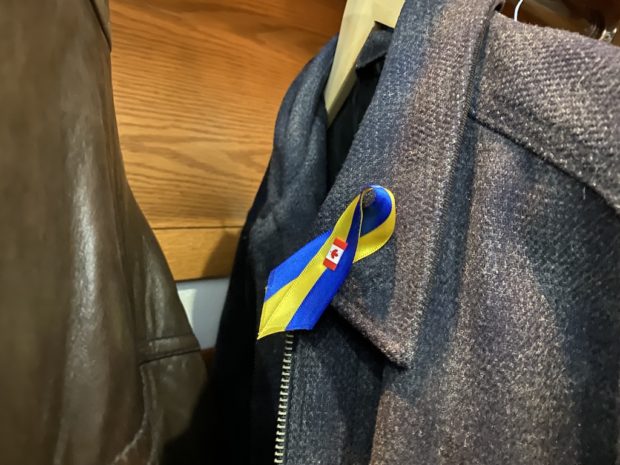
Listen to audio story: Edmonton Church Rallies for Ukraine
Click here for audio story transcript
(Originally aired April 28, 2022)
How I Got This Story:
On my flight into Edmonton, I sat next to a Canadian photographer returning home from a trip to Europe. He’d visited Poland and Ukraine, taking pictures of refugees at the border between the two countries. As we flew over the snow-covered plains of Alberta, he looked out the window and said, “Yep, this is what Poland looks like.”
I was heading to Edmonton to find out how Ukrainian-Canadians there are responding to the current war in Ukraine, and how they’re welcoming the new arrivals who’ve fled the violence. I knew, on a surface level, that Eastern Europe and Western Canada can both get bitterly cold, but it hadn’t occurred to me that the two places, halfway around the world from each other, might actually look similar from the sky.
In fact, as I learned from historian Jans Balan, director of the Kule Ukrainian Canadian Studies Centre at the University of Alberta, the Canadian government actively recruited Ukrainians to come and farm the cold Canadian prairie in the late 19th century. Canada even instituted a law similar to the United States’s Homestead Act — if settlers would come and cultivate a piece of land, then they could have it. Because of similarities in weather and topography, Ukrainians could grow the same crops in Canada as they’d grown back home. It was a natural fit.
Many Ukrainians took the opportunity, and today there are Ukrainian communities in Canada that go back four or five generations. Outside Ukraine and Russia, Canada is home to the largest population of Ukrainians in the world.
Though the current war in Ukraine is entering its third month, the United States did not announce a formal plan to admit people fleeing Ukraine until late April. Canada, on the other hand, began granting three-year residence to Ukrainians in mid-March.
My beat for the Covering Religion seminar is Orthodox Christianity. Since Russia’s assault on Ukraine began soon after our class started, I’ve focused on New York’s Ukrainian Orthodox churches, reporting on one on the Upper West Side and one in the East Village. New York has the largest Ukrainian population in the United States, but Ukrainians here are not nearly as visible as they are in some towns and cities in Canada.
More than 100,000 Ukrainians live in Edmonton, making up more than 10 percent of the city’s population. In 1983, the Edmonton Ukrainian community created the world’s first-ever monument to the Holodomor, a famine that killed millions of Ukrainians under Joseph Stalin 50 years earlier. The monument stands outside Edmonton’s City Hall, not far from another one dedicated to Alberta’s Ukrainian pioneer women. This other statue — the bronze “Madonna of the Wheat” by sculptor John Weaver — wears her hair atop her head in a traditional Ukrainian braid.
Many of the city’s Ukrainians attend one of five Ukrainian Orthodox churches. (Some instead attend St. Barbara’s Russian Orthodox Cathedral, which was founded by Russian Orthodox missionaries to serve Edmonton’s Ukrainian community in 1902, though I learned that some St. Barbara’s members, wanting to distance themselves from the Russians, have been visiting Ukrainian churches since the war started.)
The largest of Edmonton’s Ukrainian Orthodox churches is St. John’s Ukrainian Orthodox Cathedral. The Rev. Cornell Zubritsky, a priest at St. John’s, was my primary contact. I found his phone number on the cathedral’s website, and he told me he’s a member of a committee assembled by the Ukrainian Orthodox Church of Canada to coordinate the national church’s response to the war. (Zubritsky grew up north of Edmonton, in the town of Vegreville, where, he said, even non-Ukrainians speak with slight Slavic accents.)
Zubritsky was the one who told me about the airport welcome booth the Edmonton Ukrainian community has organized to welcome refugees from the war. He himself has taken shifts at the booth, and many others who attend the cathedral have, too.
When I got to the airport, I sat at the welcome booth for about an hour. (No one arrived from Ukraine, so I talked with Svitlana Fizer, who was staffing the booth, and she taught me the Cyrillic alphabet.)
The next day, I interviewed Zubristky and attended a welcome event for newly-arrived Ukrainians at the Ukrainian National Federation building. I met one young boy, Artom Yershov, who’d recently fled Ukraine with his parents. When I asked him whether he hopes to return to Ukraine someday, he said no. “I want to live in Edmonton, Canada,” he said.
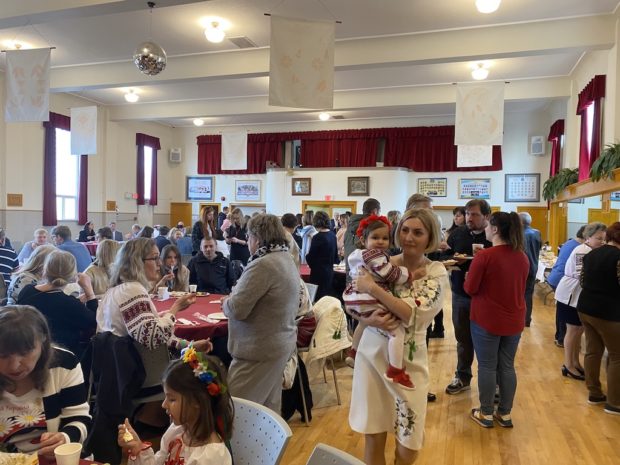
On Palm Sunday, I went to the service at St. John’s Cathedral and heard Zubristky preach a sermon about Jesus accompanying the community in their difficult time through the suffering of his passion during Holy Week.
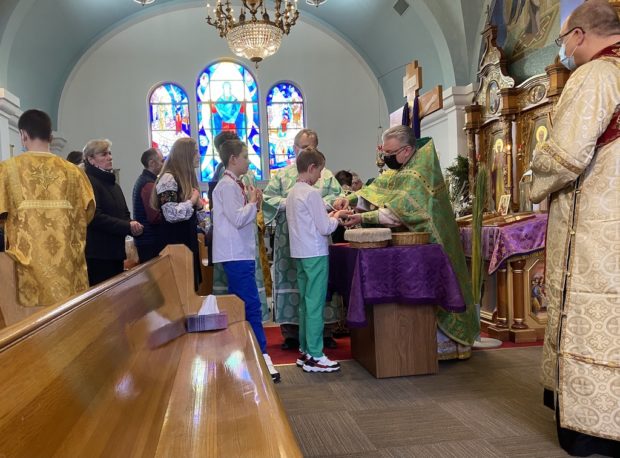
Late Sunday night, I sat at the airport welcome booth until 1:00am, waiting for arrivals from Ukraine. More than 300 have come since the war began, and many have joined relatives already established in Edmonton. But some have arrived at the airport without a plan, and without anyone to pick them up. The welcome booth volunteers have driven new arrivals to the Edmonton Inn, which is offering them free temporary accommodation, and then quickly matched them with volunteer host families.

Iryna Polishchuk is in-between these two situations. In Ukraine, she was an elementary school English teacher. Her daughter lives in Vancouver. When Russia started bombing Ukraine, she was about to return home to Ukraine from a vacation in Greece. Her daughter, who lives in Vancouver, called her to tell her she must not return to Ukraine, but should come to Canada instead. Polishchuk flew to Vancouver, with only what she’d packed for Greece — no coat, no boots. (The weather in Edmonton is still quite cold at this time of year. It snowed twice while I was there.)
Polishchuk stayed in Vancouver for several weeks, but she and her daughter ultimately decided it would be best for her to go instead to Edmonton, more than 700 miles away. Since the Ukrainian community is bigger in Edmonton, she’d have a better chance there of finding a job. Polishchuk’s daughter’s long-distance partner lives in Edmonton, so she is staying with him while she looks for work. In the meantime, Ivan Lypovyk’s brother gave her a ride to a welcome event for Ukrainians at the Ukrainian National Federation building, and a woman she met on the Facebook page for Ukrainians in Edmonton offered to take her to the mall to help her find a coat. She’ll need one, as other Ukrainians who’ve arrived in Edmonton before here have found, but she’ll also have a warm community to sustain her.
A Life of Double-Belonging: Some Religious Leaders Practice Two Faiths
In a dimly lit Roman Catholic church on a recent Monday night in Manhattan, around a dozen congregants sit in the pews watching the Rev. Michael Holleran as he leads them in what is known as contemplative prayer. During this kind of prayer, one word of the congregant's choosing is silently repeated over and over again. There is some singing, and some prayers said aloud throughout the hour-and-a-half-long worship. Every so often Holleran rings a bell three times, which is meant to awaken worshipers from “sleep and into a consciousness of God’s presence.” This form of prayer is often compared to meditation due to the silent repetition of one word and the focus required. Peace, love, truth; these are just a few of the word choices worshipers might repeat. If their mind wanders, they are instructed to return to the word.
Contemplative prayer was adopted by some Catholics in the 1970s and takes inspiration from faiths like Buddhism, so it’s no wonder that in addition to being a Catholic Priest, Michael Holleran is also a Buddhist Sensei.
Michael Holleran serves as the priest at the Church of Notre Dame, a Catholic church in Morningside Heights, but once a week he leads a Buddhist Zen Meditation session over Zoom. He practices double-belonging, a term coined in 2009 by Paul Knitter who wrote a book titled “Without Buddha, I Could Not Be a Christian.” Knitter is a major influence on many Catholics who subscribe to Buddhist ideology. He insists the two faiths do not conflict with one another. The teachings in his book have spread to some, including professors of religion like Chad Thralls of Seton Hall University and Catholic priests like Robert Kennedy, based in New Jersey. They too have followed a life of double-belonging as outlined in Knitter’s book.
Buddhism and Catholicism have been compared to one another in the past. In 1870, The Atlantic, an American magazine that was first published in 1857, reported on the similarities between the two faiths. “The Tibetan lama listened respectfully to the Jesuit priest and replied, ‘Your religion is the same as ours,’” reported Lydia Maria Child.
Buddhism originated around 1,500 years ago. Founded by Siddhartha Gautama the faith spread from India to the rest of Asia and eventually the world. In the tradition life is seen as a cycle, entailing suffering and rebirth. Finally, one can achieve enlightenment and break the cycle. Catholicism traces its roots to Palestine in 30 CE following the teachings of Jesus Christ. Catholics believe that if you confess your sins and base your life around the 10 Commandments you’ll go to Heaven after you die. Some Catholic theologians insist that the two faiths do not conflict, but in fact, build on one another.
As Holleran has explored his religious identity, he says he has found a “vibrant synthesis” between Buddhism and Catholicism.
“I don't see any conflict among any of these traditions,” he said. “If you're actually going deep enough into what they're really all about, that is to say, finding union with God, making the world a better place, transformation of your own consciousness, etc.”
For Holleran, this approach is specific to Catholicism and Buddhism and doesn’t necessarily extend to other faiths like Judaism and Christianity. A joint practice of those faiths might be harder to fit into the double-belonging theme.
Raised as a Roman Catholic, Holleran, 72, joined the Jesuits at Fordham University, where he took a course in various religions and learned about Buddhism. Holleran eventually became a Carthusian Monk in France, a contemplative order. Today, as the priest at the Church of Notre Dame, he keeps his two faiths separate, that is until he leads the Dragon’s Eye Zendo Wednesdays on Zoom. During Zen meditations, Holleran mentions Catholic scripture or figures but doesn’t mention Buddhism during Catholic services. Some people attend both the contemplative prayer and the Zen meditation each week like Chad Thralls.
Professor Thralls, who teaches at Seton Hall University, a Catholic institution, says that many of his students are excited to learn about faiths other than Catholicism. Therefore, whenever he involves Buddhism in his coursework, students are engaged. Holleran and Thralls cite theologian Paul Knitter as a source of inspiration in their journeys with double-belonging.
The Coining of the Term
Knitter, 83, began studying to be a priest in Rome during the Second Vatican Council, a major reexamination of Catholicism that took place in the 1960s. At the time, the Catholic Church encouraged students to learn about other religions in addition to Catholicism. This started his interest in other faiths and he began to question Christianity as the “superior religion.” Eventually, this inspired Knitter to write a book about how Christianity is just one of many traditions. From then on Knitter said he understood Christianity from a Buddhist perspective.
“It was as if I was wearing Buddhist glasses while reading Christian texts,” he said. Knitter was ordained a Catholic priest but then left the priesthood and became a professor of theology.
Knitter has questioned whether he is Christian or Buddhist in the past. Today, he is a member of a Christian parish and a Buddhist community. On the other hand, his faith identity has been a controversial topic in the academic community. Knitter says he has faced some backlash for preaching double-belonging. Many religious scholars think you cannot be both, but Knitter disagrees.
“Religions need each other to understand themselves,” he said.
This inter-religious study is called comparative theology, and it is more broadly accepted now in mainline Christianity. Knitter suggests this is likely because of the intercultural world we currently live in. In the 1980s Knitter and his peer, John Hick proposed a pluralistic understanding of religious diversity or as Knitter puts it “a pluralistic understanding of the world's religions.”
During one of Chad Thralls’ recent lectures at Seton Hall University, he explained the first chapter in Knitter's book to the students, then asked them some questions to see what they thought of it. He references Knitter each semester he can. To a room full of undergraduate students, all raised Catholic, he presents this prompt: “In the book, Knitter notes that one of his students questioned whether he was ‘spiritually sleeping around’ by practicing both Christianity and Buddhism. Is Knitter cheating on Jesus?” During that class discussion, Thralls says none of his students believed Knitter was.
Not every Catholic is on board with double-belonging and the ability to whole-heartedly practice two faiths. Another Catholic priest, the Rev. John D. Dreher, was outspoken about the matter in an article for Catholic.com. For him, the two are incompatible.
“In Catholic teaching, all men are creatures, called out of nothingness to know God. All men are also sinners, cut off from God and destined to death,” he said. “Eastern religions, in contrast, lack revelation of God as a personal Creator who radically transcends his creatures. Though possessing many praiseworthy elements, they nonetheless seek God as if he were part of the universe, rather than its Creator.”
Still, Holleran, who doesn’t mention Buddha during his Catholic services, is fairly open about his practice of both religions. His personal website plainly states his credentials as a former Carthusian Monk and Priest and as a Sensei. It also references Knitter and double belonging.
Holleran says he hasn’t received much backlash from anyone about practicing double-belonging. He continues to lead Catholic services and Zen meditations. Additionally, he gives lectures about the intersection of the two faiths to students every now and then.
Of the potential for backlash, he said “Mystics have been crucified in all traditions, not just Christian, Jewish, Muslim. They're always a problem, a danger because they challenge the limitations of the institution.”
The New York Archdiocese has not replied to repeated requests for comment about whether double belonging is something they support among their priests.
The Retreat
On April 10th and 11th, the University of Wisconsin-Madison held a retreat in which around 25 “Interfaith Fellows” from the university’s Center for Religion and Global Citizenry practiced a variety of faiths to better understand them. They met in person at Holy Wisdom Monastery, a Catholic Monastery of Benedictine nuns. During the retreat, they experienced contemplative prayer, Zen meditation, and Tibetan meditation, among other practices.
Paul Knitter was one of the event organizers. He says they focused on similarities and differences between faiths but argued that many have similar goals.
“Through the contemplative practice, we discover a larger self,” Knitter said. “We’re finding ourselves as part of a larger reality, which is called by different names. God, Nirvana, Allah, Gahe.”
Although none of the students definitely said they would practice double-belonging after the retreat, many said it was an enlightening experience.
In an ever-globalizing world, religions from the East and West build on one another, according to those who practice double-belonging. Scholarship has further spread this idea. “Without Buddha, I Could Not Be a Christian” has outsold all of Knitter’s other books. He said he gets thank you emails once a month, even now. Regardless, Knitter doesn’t think most people will ever become pluralistic in faith, but they may become more open to the idea that some are. “People might be more open to learning from others,” he said.
A version of this story has been republished by Religion News Service.

